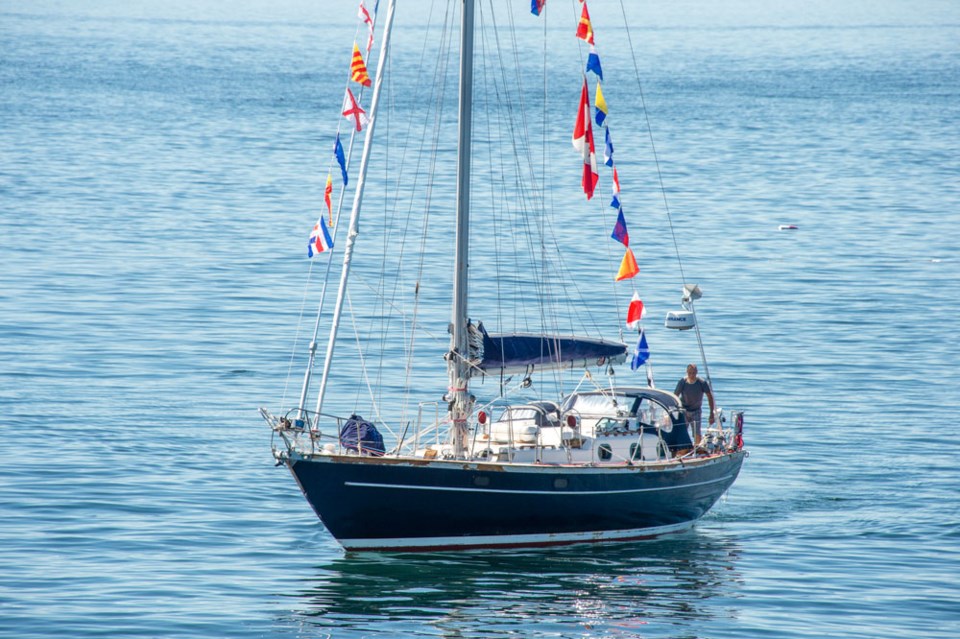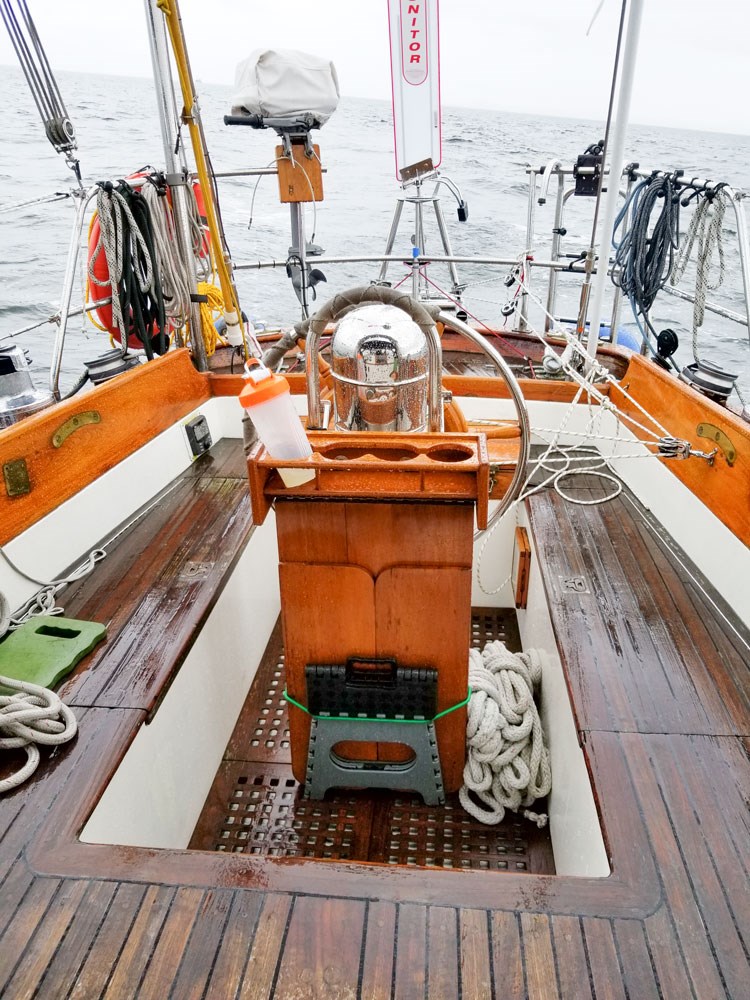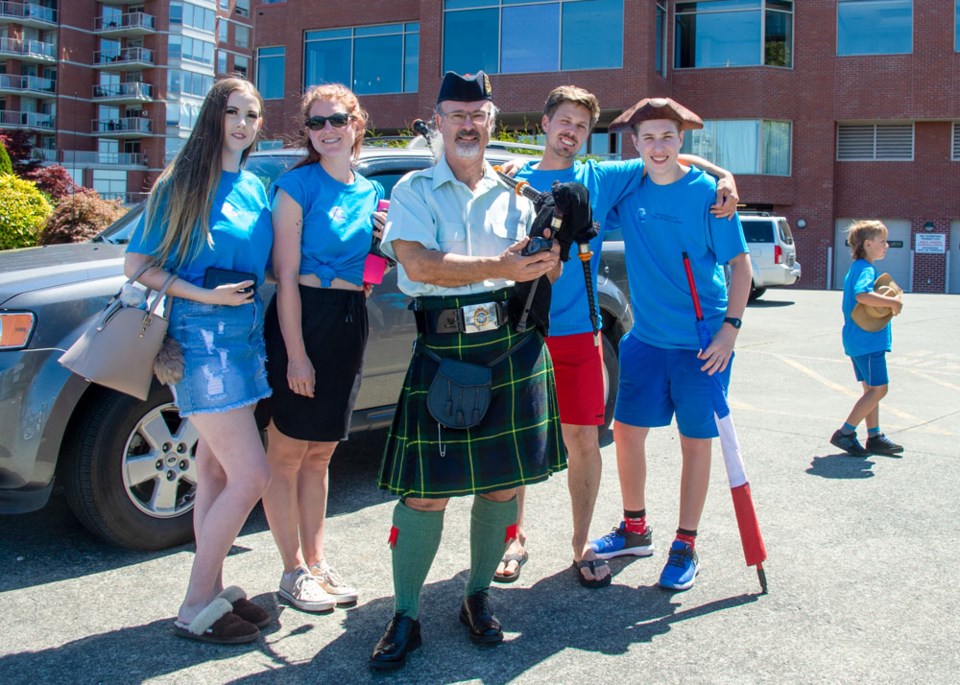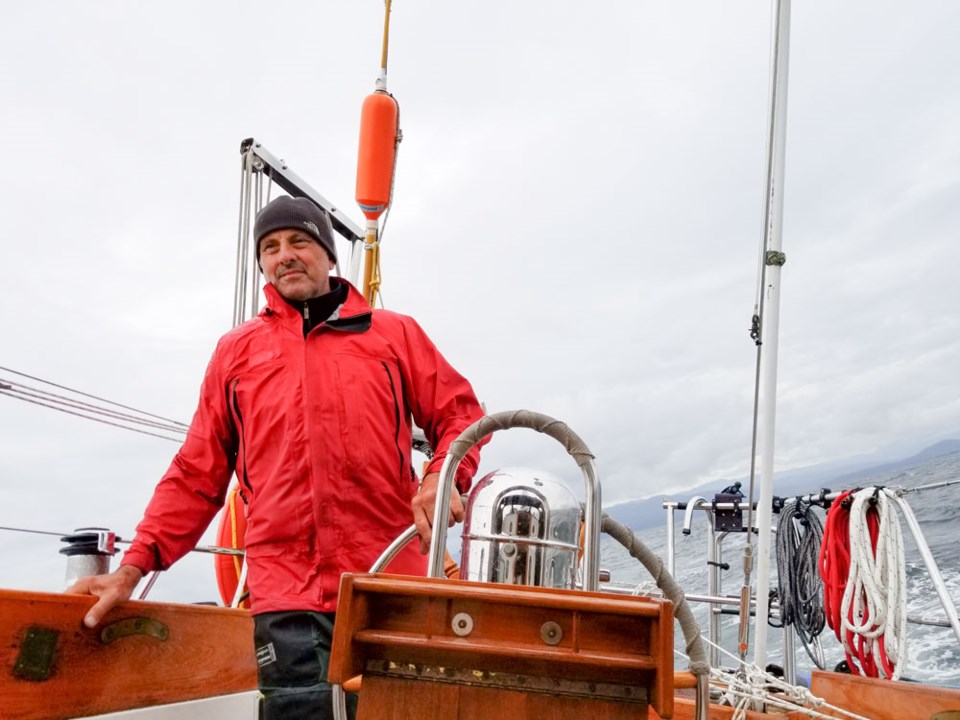Bert ter Hart spent 267 days at sea on a solo journey of the world, his 13-metre boat the Seaburban, his nautical skills and the support of family, friends and strangers alike sustaining him during the voyage.
The former Estevan resident is back in Canada, after a voyage in which he became the first person from North America, and just the fifth person ever, to complete a solo, non-stop circumnavigation around the world via the five great capes, using only celestial navigation.
GPS? Nope. Just a sextant, a sailor’s almanac, log tables and pen and paper – just like they did in the 15th century.
Ter Hart arrived in Victoria on July 18, with friends, family and others excited to see him arrive on his boat.
“It was a huge relief, firstly, because you’re worried about so many things,” he told the Mercury. “You’re worried about the boat staying in one piece. You’re constantly worried about the weather and especially coming back, there’s so much commercial traffic.
“So you’re worried about getting run over, which is probably the biggest risk, anywhere near land, is the commercial traffic. And there’s a lot of commercial traffic, even now, with COVID.”
The journey
Ter Hart embarked on his journey Oct. 28 of last year to little fanfare, with only a few people on hand to see him try to sail the five capes: South Cape in New Zealand, South East and Cape Leeuwin in Australia, Cape Agulhas in South Africa and Cape Horn in Chile.

Sailing has been a big part of terHart’s life. He is an active member of the Gabriola Island Power and Sail Squadron. He is also a member of the Silva Bay Yacht Club, Gabriola Island and the Ocean Cruising Club. He has skippered his boat several times to the Bering Sea while rounding Vancouver Island and Haida Gwaii
But he’d never tried anything close to this.
Throughout the journey, he witnessed remarkable beauty and encountered great challenges. The storms could be ferocious. The waves on the southern ocean were powerful. The calms and the sunsets and flying fish are marvels. He tried to capture the footage on his iPad, but he doesn’t believe he did it justice.
“I’m from the Prairies, so the flat around me is something that I feel very comfortable with. I think some of the most beautiful places on the earth are on the Canadian Prairies. I know people who live there might disagree with me, but that’s just how I think about it.”
If he would have stayed in the south ocean long enough, he believes he would have died, because the strongest storms pack winds in excess of 150 kilometres per hour and waves taller than a five-story building.
At times, the boat was completely under water, and the mast was horizontal and in the water. But even in those moments, the waves weren’t big enough to turn the boat upside down.
“You just simply can’t trifle with the storms, and my goal was to avoid the storms as much as humanly possible, which is easier to do now with the advanced weather (forecasts).”
The calm can be draining as well. There’s no wind, but the motion on the boat is still violent from the waves.
“There’s no way to steady the boat. You just sit there and get brutalized by the motion.”
The Seaburban held up well throughout the journey. He repeatedly said he was worried about sailing the boat to bits. He sailed conservatively, not venturing too far south until he had to get around the south cape of New Zealand.
“The further south you go, the more demanding the conditions are. It’s unbelievably hard as it is, but to go farther south, you need a different kind of boat.”
The conservative approached is a big part of why the Seaburban was able to survive, he said. At one point, he lost the halyard – the line that holds up the most important sail on the boat – which added at least two weeks coming up through the Pacific Ocean. But it was the only large breakage sustained, even though he “beat the living daylights out of it.”
“The chances of getting around (the world) with the boat in one piece are … less than 50-50. So there was a 50 per cent chance when I left that I wasn’t going to complete, just because I’d break the boat.
Eating and sleeping
Eating and sleeping were challenges. He had to be very regimented in what he was eating, since he had to bring enough food for the nine-month journey. For breakfast, he had oatmeal or granola. Eggs were a rare treat early in the journey, until they expired.
For lunch, he had dried nuts or fruit, and a tin of tuna or salmon. Supper would be pasta, rice or quinoa, and a can of vegetables such as corn or beans. Pesto and feta cheese were served with the pasta.
“Any high-fat foods would last incredibly long. You don’t have to refrigerate cheese at all. You don’t have to refrigerate high-fat yogurt.”
He rationed the food, but if the food was about to go bad, he gobbled it up.
“All of the good snack food disappeared quickly, so by the time … five months rolled around, there was no more good stuff to eat, and I was just right down to the basics.”
Before reaching Cape Horn, he was down to 800 calories per day to ensure he had enough food to make it home. Despite his disciplined and rationed approach, he underestimated his appetite because of the workload associated with the voyage.
“I’ve been to some pretty harsh places. I thought I had a good idea, but I had no idea how much food I actually needed.”
In the southern ocean, he should have been eating 3,000-4,000 calories per day. If he would have consumed that much, he would have run out of food. So he ate when he thought he needed to.
Sleeping was an even tougher task. He averaged about four hours of sleep a day, and if he was lucky, those four hours came in a pair of two-hour increments.
“You sleep, strapped down, into a bed, so I had a bed or basically a couch. So I couch-surfed for nine months around the world,” he said with a laugh.

In his boat, there are six bunks, two of which are completely unusable, so they were for storage, and then there are others at the stern of the boat that are useable, but the best place to sleep were two “benches,” low and in the centre, where the motion was the least noticeable.
Those benches, or couches, were six feet in length, cozy for the six-foot ter Hart.
“Obviously you’re laying down, but you’re strapped in with a seat belt across your hips, and you have it pulled as tight as you possibly can. So I’m absolutely nailed down to this bed. Across the bed, there’s a cloth that keeps you from flying out, and that cloth is secured very, very tightly.”
On four or five occasions early in the trip, he was thrown out of bed when he wasn’t strapped down, because he thought the restraints weren’t necessary.
“I woke up two or three times levitated, which is an interesting experience,” he said.
You have to pick and choose the two hours for sleep. Conditions have to be relatively stable.
“If you expect the weather’s going to be changing, or there’s a shift or there’s a course change or something’s going to happen, then obviously you can’t go to sleep, because the danger of that is just too great.”
During the day, he tried to get in one 20-minute nap.
By the end of the journey, he had fallen asleep in every position possible, including steering the boat, grinding the sheets on the wenches, eating and writing at his desk.
“I would know when my ability to make decisions was being degraded by my lack of sleep,” said ter Hart.
To top it off, he didn’t sleep for the final days of the journey.
Inspiration
One of the highlights from his voyage was reconnecting with people from the Estevan area he hadn’t talked to in a long time. His mother and father and family spent a lot of time here, but it’s been decades since they left.
“It has allowed my father and my family to reconnect with old friends and acquaintances from Estevan who have moved all over Canada. So my dad is constantly getting emails and phone calls and messages from people, from friends and acquaintances, from his time in Estevan. Same thing with me.”
In the interview with Lifestyles early this year, ter Hart said he discovered his love for sailing, and wide open spaces, while living in Estevan and spending time on Boundary Dam.
“I hadn’t expected it or wanted it, but I must at least be grateful and humbled by it. It’ll take some while before I can understand and grasp why so many people seemed so engaged by the voyage.”
When he embarked on the journey, ter Hart said his goal was to inspire children to follow their dreams and pursue careers in the sciences. But by the end, he was the one who was inspired, based on the messages he received from people around the world.
“It’s unbelievably powerful to know that there are people pulling for you – genuine, sincere, caring people that you’ve never met. Every now and then, I would get a snippet of something that would lift me up from the deepest, darkest hole, and make me say ‘I can do it.’”
“The safest man on the planet”
The final kilometres were among the slowest. At one point, a large ship came behind him, and was squeezed between ter Hart’s boat and a couple of fish boats, leaving ter Hart with little room to manoeuvre.
“After he passed, the wind just shut off, and suddenly I’m just rolling around in this really miserable sea.”
He needed 13 hours to travel the final 13 kilometres.
Once he arrived back in Victoria, there was the thrill of seeing those who had come to greet him after he was gone nearly nine months.
As a bonus, he didn’t have to self-isolate upon returning to Canada. His sister Leah had talked to the superintendent of the Canada Border Services Agency in Victoria, while other wrote letters, saying he was the “safest man on the planet,” since he had been at sea long before COVID-19 was first diagnosed in China.
After convincing border officials, they pleaded his case to public health.
“There are no check boxes on your form for me, so I’m not going to fit into any convenient category that someone can just plop down on a piece of paper by filling in a form, some pre-formatted form,” said ter Hart.
He admits he was not co-operative when screened by officials, so he could prove he was unlike anyone else they had encountered.
“The customs officers were great. They were fantastic, they were professional, and they were courteous,” said ter Hart.
Reconnecting
Since returning home, he’s been hosting open houses on the boat, interacting with the media, spending time with his family and trying to explain to people the things he saw and how he was able to circumnavigate the world.
“I haven’t left my family’s side since I got back.”

He's reconnected with his wife Nani and other members who reside in southwest B.C.
And, of course, he’s been trying to catch up on his sleep.
“There’s a massive difference between being at sea, and being on 24-7, and suddenly being on land and having a whole different set of challenges. It’s taken about four days for my body to realize that it no longer has to be on standby 24-7 and on a high alert. Suddenly I got really, really tired, So if I stop doing anything, then I would absolutely fall asleep just then and there, just like on the boat.”
He’s surprised with the attention he has received, with requests from national and international media outlets.
He would have been content to return with just his family present, but instead, there was a throng of reporters waiting for him.
“I’m humbled by it, I’m just completely floored by it,” said ter Hart. “I don’t completely understand it, in the sense that I never left seeking any notoriety whatsoever. There was an opportunity for a Canadian to be the first (from North America) to do what I did, in a very limited context.”




